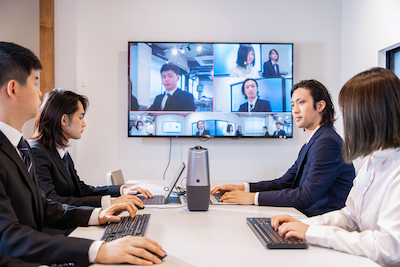
Evolving Views on Remote Work: Room Camera's Vital Role

More than three years have passed since the global onset of COVID-19, and room cameras have had a transformative impact on our work, which continues to unfold. As companies adapt to new norms, remote work has emerged as a defining aspect of modern business operations. Amidst this evolution, the incorporation of advanced technologies like room cameras has played a pivotal role in reshaping the landscape of remote work.
Once considered a luxury, remote work has become necessary for businesses across various sectors. Companies are now grappling with the challenge of redefining their operational models. Different industries are approaching remote work, and the strategies they are employing to make this new paradigm successful
In this article, we explore how different industries strategically navigate the remote work paradigm, focusing on the integral role that room cameras now play in fostering collaboration, communication, and productivity.
Remote Work through the Eyes of Different Industries
It may seem that many industries are shifting to remote work, but in reality, 59% of full-time workers in the US are working on-site, 12% are working remotely, and 29% are in hybrid work.
To understand the views of different industries about remote work, let us go through each industry's perspectives and how they adapt to these changes:
Tech - Pioneers of Remote Collaboration
Given its reliance on digital tools and platforms, the technology sector has been at the forefront of remote work adoption. They are the most flexible industries that could adapt to these changes. Tech companies quickly transitioned to remote work, leveraging their expertise to create seamless virtual work environments.
- Virtual Collaboration Tools: Since Tech companies have been utilizing video conferencing, project management, and communication tools before, the use of them for remote working to foster collaboration among remote teams has come in handy and easily. Platforms like Slack, Zoom, and Microsoft Teams have become essential for real-time interactions.
- Flexibility and Autonomy: Many tech companies emphasize outcomes over processes, allowing employees to choose their work hours and locations. This autonomy boosts productivity and job satisfaction.
- Digital Onboarding: Remote tech companies have perfected the art of virtual onboarding, ensuring new employees feel connected and aligned with company values from day one.
Service/Hospitality - Redefining Customer Interaction
Industries centered around in-person services faced significant challenges during the pandemic. Since their industry heavily relies on in-person collaboration, the pandemic has become a struggle for them. However, they have managed to adapt and find innovative ways to offer value remotely:
- Virtual Consultations: Service-oriented businesses such as consulting firms and financial advisors have shifted their interactions to virtual platforms, providing personalized advice through video calls.
- Contactless Services: The hospitality sector, including restaurants and hotels, has embraced remote technology for contactless check-ins, digital menus, and online reservations. For example, a QR code generator can help create easy access to menus, payments, and booking pages with just a smartphone.
- Enhanced Communication: Clear and transparent communication has become pivotal. Regular email updates, social media engagement, and interactive websites have helped service-based businesses stay connected with their customers.
Education - Embracing Hybrid Learning Models
Education has a significant impact on hybrid work and remote work. In 2022, 54% of employees with a bachelor’s degree will have worked remotely, compared to 18% of employees with a high school degree (BLS's American Time Use Survey).
Similarly, the education sector has undergone a remarkable transformation, adopting hybrid learning models that combine traditional classroom teaching with remote instruction:
- Virtual Classrooms: Educational institutions have integrated video conferencing tools to conduct live virtual classes, enabling students to interact with teachers and peers from the safety of their homes.
- Digital Resources: Online libraries, e-books, and interactive learning platforms have replaced traditional textbooks, making educational resources accessible to remote learners.
- Teacher Training: Schools have invested in training educators to effectively manage remote and hybrid classrooms, ensuring quality education regardless of the mode of instruction.
Since higher education has been utilizing technology, they are expected to know how it works; thus, companies trust them to work remotely.
Healthcare - Telemedicine's Rise to Prominence
The healthcare sector has embraced telemedicine to ensure continuity of care while minimizing in-person interactions:
- Remote Consultations: Patients can now consult doctors through video calls, reducing the need for physical visits for routine check-ups and non-emergency medical concerns.
- Prescription Delivery: Pharmacies and healthcare providers leverage technology to deliver prescriptions and medications directly to patients' homes, enhancing convenience and safety.
- Remote Monitoring: Wearable health devices and apps allow patients to monitor vital signs and share data with healthcare providers, enabling proactive intervention.
Room Camera: The Key to Different Hybrid Work Perspectives
The work landscape has recently transformed drastically, with the adoption of hybrid work models becoming increasingly prevalent. In this new era of work, room cameras have emerged as indispensable tools, bridging the gap between in-person and remote collaboration. These cameras are revolutionizing how various industries operate, ensuring seamless communication, enhanced productivity, and efficient collaboration.
Regardless of your industry, there is one high tech room camera on the market that can deal with the changes brought by remote working. With the use of these room cameras, everything becomes smooth and seamless, even if you attend virtual meetings, virtual consultations, online classes, or remote telemedicine.
This device is the Colpo AI Huddle Series, made with the finest technology and featuring a 360 omni camera and a 4K webcam. This series is comprised of the Coolpo AI Huddle Pana and Coolpo AI Huddle Mini Lite devices, both huddle camera devices that are perfect as hybrid meeting equipment.
Coolpo AI Huddle Pana
For a more immersive and futuristic camera, the Coolpo AI Huddle Pana offers a wide-angle field of view with its 360 conference camera. Aside from that, it is equipped with 360-degree speakers and four smart microphones with a 15-foot pick-up range.
But what makes this device futuristic is its AI-supported feature through MeetingFlex® Technology. This features a voice and movement tracking system. A design where the device can recognize and track the user's voice and gestures. A smart camera that can amplify your virtual meetings with these AI-driven insights.
Coolpo AI Huddle Mini Lite
The Coolpo AI Huddle Mini Lite is a small device with a big impact that can even break the barriers of distance. With its flexibility and portability, this 4K webcam camera has a 60°, 90°, and 120° horizontal FOV. It also has an electric microphone, so people can hear crystal-clear audio from you.
The Coolpo Mini Lite’s AI-driven capability is made possible by MeetingFlex® Technology. It has auto-framing capabilities through its Division and Frame Master features.
Conclusion
In conclusion, as the global work landscape continues to evolve in response to the ongoing challenges posed by the COVID-19 pandemic, the role of room cameras in facilitating remote work has become increasingly vital. Various industries have embraced remote work in their own unique ways, and the integration of advanced room camera technology has played a central role in reshaping their collaboration, communication, and productivity strategies.
The Coolpo AI Huddle Series, represented by the AI Huddle Pana and AI Huddle Mini Lite devices, has demonstrated the potential to revolutionize the remote work landscape. In this new era of hybrid work models, room cameras are instrumental in bridging the gap between in-person and remote collaboration for seamless communication, enhanced productivity, and efficient collaboration across industries.
Recent blogs
How Sales Agents Build Stronger Client Connections with a Headset for Cold Calling



%20(1).jpg)






